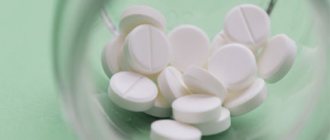The anxiolytic effect of Phenazepam on the body allows you to reduce emotional stress, cope with feelings of anxiety, fear and restlessness. The effect is due to the influence of the limbic system on the amygdala.
The sedative effect allows you to cope with anxiety and fear. The effect is achieved by influencing the reticular formation of the brain and the nucleus of the thalamus. The hypnotic effect of the medication allows you to normalize the mechanism of falling asleep and eliminate insomnia, which is associated with the influence of emotional, autonomic and motor negative factors. The hypnotic effect of Phenazepam in humans is achieved by suppressing the cells of the reticular formation of the brain stem.
The drug has an anticonvulsant effect by activating presynaptic inhibition. This makes it possible to reduce the synthesis and propagation of the convulsive impulse without affecting the excitation reaction.
The muscle relaxant effect allows you to restore muscle function, reducing their tone. This effect of Phenazepam on the body is due to a weakening of the activity of polysynaptic and monosynaptic reflex arcs.
Phenazepam has no or negligible effect on the productive symptoms of psychotic etiology (delusional thoughts, hallucinations, affective disorders).
Pregnancy and Phenazepam are incompatible, well almost...
During pregnancy, Phenazepam is prescribed extremely rarely.
Its use is advisable only if there is a threat to vital signs. The composition of the drug has a toxic effect on the fetus and increases the risk of having a child with congenital defects. The likelihood of pathology increases when taking Phenazepam in the early stages of pregnancy (first trimester).
In the third and last trimester, it is also dangerous to take Phenazepam, since it can cause depression of the central nervous system of a newborn baby, and if necessary, it is better to replace this drug with safer analogues.
If a woman takes the drug throughout her pregnancy, the baby develops a dependence syndrome. After the birth of a newborn, you will have to deal with the consequences of withdrawal. Young children have an immature central nervous system, which is sensitive to the suppressive effects of benzodiazepines.
Depressed breathing, decreased muscle tone, hypotension, hypothermia are possible consequences of taking Phenazepam in late pregnancy and just before childbirth.
In exceptional cases they do prescribe - when?
The medicine has become widespread in the fight against diseases:
- syndrome that occurs due to alcohol withdrawal (abstinence);
- the presence of epileptic seizures or seizures of another nature in a pregnant woman;
- diagnosed psychiatric illnesses, such as schizophrenia;
- the presence of neurological diseases that caused severe irritation, anxiety or insomnia.
The drug is prescribed by a doctor, and the dose and course of treatment are selected depending on the patient’s condition. The drug can be administered intramuscularly or intravenously. Today, pharmacies also have the option of medicine in tablets.
But apparently in vain!
Phenazepam is quickly addictive. In order not to harm the patient, the dose is first gradually increased and then decreased. The course of treatment should not exceed two weeks, otherwise the risk of addiction increases.
The drug can cause a number of side effects; overdose and numerous side effects are possible, which must be taken into account when prescribing it to a pregnant woman.
The risk of allergies increases, manifested in the form of redness on the skin, severe itching and profuse rash. Phenazepam negatively affects the digestive system, resulting in vomiting, nausea, increased metabolism, yellowness of the skin, and abnormal bowel movements.
At the same time, the number of platelets, erythrocytes and leukocytes in the blood decreases. Cases of urinary incontinence or, conversely, delay in urine output have been recorded. The medicine can lead to hallucinations, severe drowsiness, visual disturbances and sudden changes in mood. A woman can suddenly move from depression to a euphoric state.
In this regard, we categorically do not recommend taking Phenazepam during pregnancy! As mentioned above, there are numerous analogues of the product that are safer and easier for pregnant women and their unborn child.
Expert opinion about this drug:
The place of phenazepam in the modern use of benzodiazepine tranquilizers
With the advent of benzodiazepine tranquilizers in the 60s, the psychopharmacological revolution was almost completed. To the somewhat earlier antipsychotics and antidepressants, a group of tranquilizers was added, which allowed mental health specialists to create a wide arsenal of drugs for the treatment of mental disorders. In our country, the most well-known and studied benzodiazepine tranquilizer is the domestic drug Phenazepam. The study of the properties of Phenazepam began in a number of leading clinics in the country, including the Moscow Research Institute of Psychiatry, since 1976. Already the first studies [1,2,3] conducted in our clinic involving a significant number of patients (143 patients) convincingly showed that the drug has a rapid (3-5 days) and pronounced ability to reduce anxiety, fear, various sleep disorders, vegetative disorders, senesto-hypochondriacal and obsessive syndromes. Thus, the discovery of benzodiazepine tranquilizers made it possible to significantly expand the capabilities of a psychiatrist, especially in the field of minor psychiatry (neuroses, obsessive-compulsive disorder, post-stress disorders, etc.).
However, after decades of widespread and successful use of benzodiazepines in world psychiatry, problems associated with the use of this group of drugs began to arise. Thus, the uncontrolled, often unjustified use of this group of drugs has led to their abuse and the formation of addiction.
The tragedy of the fate of benzodiazepine tranquilizers lies in the fact that in addition to their powerful and rapid pharmacotherapeutic action, these drugs also have some addictive potential. The ability of benzodiazepine derivatives to cause drug dependence is widely described in the literature [4,5,6,7,8]. However, a balanced assessment of this effect has yet to be made.
Currently, a lot of work has been done to determine the duration of benzodiazepine therapy courses, since the main problem leading to the formation of addiction is unreasonably long-term use of this group of tranquilizers. Thus, the well-known Balter MB study [9] showed that in the USA by 1979, more than 15% of patients taking benzodiazepines took them for more than 1 year, and by 1990 this number increased to a quarter of all those taking anxiolytics. A pharmacoepidemiological study of outpatients revealed that among patients taking benzodiazepine derivatives, only 5.6% took them for less than six months, while the rest took them for longer periods [10]. The data presented convincingly show that the problem of abuse of drugs in this group is associated primarily with unreasonably long courses of treatment.
Since the 90s, in connection with the described problems, most international and domestic recommendations suggest sharply limiting the duration of treatment with benzodiazepine tranquilizers to 1 month or even 1–2 weeks to relieve acute symptoms [7, 11, 12]. A number of measures were taken to limit the frequency of prescriptions, which, however, led to controversial results. Thus, a program conducted in New York State from 1988 to 1990, limiting prescriptions for tranquilizers, led to a decrease in their use by 57%, however, in parallel, the use of other psychoactive substances, primarily barbiturates and alcohol, increased [13]. At the same time, despite the emergence of new highly effective psychotropic drugs, primarily the latest generation of antidepressants (selective serotonin reuptake inhibitors - SSRIs, selective serotonin and norepinephrine reuptake inhibitors - SNRIs) and pregabalin, the range of use of benzodiazepine tranquilizers remains wide and covers almost all nosologies . In the field of minor psychiatry, benzodiazepines remain indispensable. In recent years, in the United States and the European Union, use (prescriptions for benzodiazepines) has remained fairly stable (Fig. 1), while in Russia it has been steadily declining (Fig. 2).
According to A.B. Smulevich et al. (1976) [14], benzodiazepine tranquilizers do not fundamentally differ in the spectrum of psychotropic activity, and the features of their therapeutic action depend on the power of the anxiolytic effect. Phenazepam, according to Yu.I. Vikhlyaeva, T.A. Voronina [10], in this regard, is one of the most highly potent (powerful) tranquilizers. In light of the problems associated with the abuse of benzodiazepine tranquilizers, current guidelines recommend the use of drugs of this group with a long half-life, which include Phenazepam [15]. In addition, an important factor for the possibility of flexible use of the drug is the existence of its injectable form.
The target of Phenazepam's action is GABAergic receptors. Due to the fact that GABAergic synapses are distributed in almost all parts of the brain (cortex, cerebellum, limbic system, basal ganglia, etc.), the drug affects most brain functions.
Like all 1,4-benzodiazepine derivatives, Phenazepam has the following effects: anxiolytic, anti-obsessive, sedative, hypnotic, vegetotropic, anticonvulsant, muscle relaxant. When taken orally, the drug is well absorbed from the gastrointestinal tract, the time to reach the maximum concentration of Phenazepam in the blood is from 1 to 2 hours, the half-life from the body is from 6 to 10 hours, excretion of the drug is mainly carried out through the kidneys.
The main clinical target of Phenazepam is anxiety syndrome of any origin (neurosis, depression, generalized anxiety disorder, post-traumatic stress disorder, panic disorder, social phobia, obsessive-compulsive disorder, psychosis). In terms of anxiolytic action, Phenazepam is one of the most powerful tranquilizers, comparable in activity to lorazepam, favorably differing from it in the duration of the effect, more than 2 times greater than diazepam, 5 times greater than clonazepam and nitrazepam [11]. In 1988, a review was made of 15 clinical studies that included more than one and a half thousand patients [16]. In most cases (60%), Phenazepam was used as monotherapy, in 40% it was combined with drugs from other groups (neuroleptics, antidepressants, mood stabilizers). Daily doses averaged 3–5 mg/day. As a result of the treatment, significant improvement was recorded in 63.3%, in 28.8% the effect was insignificant and only in 7.9% there was no effect. Phenazepam turned out to be the most effective in the treatment of mental disorders of the neurotic level, in the structure of which anxiety predominated. Already in the first days after the administration of Phenazepam, a significant decrease in anxiety tension, irritability, sleep disturbances, and somatovegetative disorders was observed. It was also noted that the effect achieved after one month of therapy was persistent. In addition, it was found that the use of the drug for affective disorders turned out to be effective in the case of predominance of depressive anxiety syndrome in the structure and, conversely, the least effective - when manifestations of vital depression and adynamic disorders predominated in the clinical picture. Based on the generalized data, it was found that the use of the drug as monotherapy for psychotic disorders was ineffective. Thus, the effectiveness of the drug decreased if the level of disorder shifted from neurotic to psychotic level.
A study of the vegetotropic effect of Phenazepam in neurotic patients at a daily dose of 3 mg in comparison with diazepam at a dose of 40 mg/day showed that the effect of Phenazepam appeared on days 4–5, coinciding with the anxiolytic effect. A pronounced vegetotropic effect occurred on the 10–12th day. The use of Phenazepam turned out to be more effective in the sympathoadrenal structure of the autonomic crisis than in the vagoinsular one. In terms of its therapeutic effect on autonomic symptoms, Phenazepam was more effective than diazepam [17].
A study of the effect of Phenazepam in agripnic disorders showed a clear positive effect on all types of sleep disorders (disturbances in falling asleep, night awakenings, early insomnia), superior in severity and speed of onset to all other tranquilizers, including diazepam. The effect of the drug, as a rule, was not accompanied by morning drowsiness and lethargy [18]. Phenazepam is also effective for sleep disorders of alcohol origin [19]. It must be emphasized that the prescription of Phenazepam as a hypnotic drug should take into account the periods currently recommended by WHO and domestic guidelines, that is, no more than 1 month [7, 11, 12].
A review summarizing the use of benzodiazepine tranquilizers in epilepsy notes that Phenazepam has been successfully used in combination therapy with anticonvulsants to treat various types of seizures [19, 20]. The introduction of Phenazepam into the regimen for the treatment of resistant polymorphic seizures led to a complete cessation or halving of their frequency in 60% of patients [21, 22].
Benzodiazepine tranquilizers play an important role in the treatment of somatic and psychosomatic diseases. Thus, in the review work of V.A. Raisky [21] noted the high effectiveness of benzodiazepines in anxiety, anxiety-phobic and accompanying vegetative disorders in cardiovascular, gastrointestinal, pulmonary and other diseases. At the same time, depending on the task, the drug had both the main anxiolytic and hypno-sedative, anticonvulsant and muscle relaxant effects. It was noted that Phenazepam in doses of 1.5–2 mg/day was superior to diazepam and nitrazepam in all types of action and showed equal results with lorazepam. Its moderate analgesic effect was also noted [23].
Phenazepam is widely used in cardiology. The main indication for treatment with Phenazepam is neurohumoral disorders of the cardiovascular system in the form of vegetative paroxysms of the sympathetic-adrenal type with cardialgia, hyperhidrosis, tachycardia, accompanied by fear of death and psychomotor agitation. The use of Phenazepam at a dose of 1–3 mg/day relieves vegetative paroxysms, sleep disturbances, and cardialgia [24]. There is evidence that Phenazepam at a dose of 1.5 mg/day has an antiarrhythmic effect on various heart rhythm disorders - atrial, ventricular, supraventricular extrasystole, paroxysms of atrial fibrillation. Phenazepam is most effective (69%) in patients with an association of heart rhythm disturbances with neurotic disorders [14].
Phenazepam is successfully used in complex therapy for coronary heart disease (CHD). Thus, already in the first days of taking the drug, night sleep is normalized, anxiety and fear for one’s life and health, irritability, and fixation on various manifestations of the disease are reduced. Phenazepam has a significant positive effect on autonomic-vascular dysfunctions - headache, sweating, respiratory arrhythmia. It was found that Phenazepam is more effective for neurosis-like disorders in patients with coronary artery disease (70%) compared to diazepam (62%) and chlordiazepoxide (49%) [25].
Benzodiazepines are widely used in anesthesiology and resuscitation. They are used for preoperative sedation, as an introductory drug for general anesthesia and potentiation of its effect.
Phenazepam is used for sedation of seriously ill patients on mechanical ventilation. The drug has the ability to block the mechanisms of psychogenic provocation of bronchial asthma attacks, which is observed in 19–51% of patients [26].
Phenazepam is used in gynecological practice in the treatment of premenstrual tension syndrome. It has been shown to be more effective than traditionally used hormonal therapy [27].
The presence of a muscle relaxant effect in Phenazepam allows its use in neurological disorders: extrapyramidal disorders, increased muscle tone (tardive dyskinesia, essential tremor, restless legs syndrome) [28]. There is successful experience in using the drug for headaches (tension headache, migraine, post-traumatic encephalopathy) [29]. The presence of sedative and vegetative-stabilizing effects in benzodiazepines, the ability to reduce spastic phenomena, and reduce the content of pepsins and hydrochloric acid in gastric juice justifies their use in gastroenterological practice in the treatment of gastric ulcers, dyskinesia of the gastrointestinal tract, ulcerative colitis, etc. [9]. At a daily dose of 2–3 mg, Phenazepam was effective for cardio- and angioneurosis, hyperventilation syndrome, “irritable stomach”, “irritable colon”, “irritable bladder” [30].
Thus, the data presented indicate the widespread use of Phenazepam in general somatic practice. The breadth and diversity of the clinical profile of Phenazepam makes it possible to use it in many areas of medicine.
At the same time, it is necessary to take into account the most important issues of tolerability, adverse events, as well as the dosage regimen and criteria for the duration of benzodiazepine therapy courses. 1,4 benzodiazepine derivatives are one of the safest groups of drugs in medicine, due to the “wide corridor” between therapeutic and toxic doses. There are no data on deaths as a consequence of treatment with Phenazepam and other tranquilizers in therapeutic doses [12], and deaths from overdose with benzodiazepines are extremely rare [31]. The drugs do not have a significant effect on the cardiovascular, hepatic, endocrine and urinary systems [32]. However, when prescribing Phenazepam, it is worth considering the possibility of its interaction with certain drugs used in both psychiatric and somatic practice. It is necessary to mention the ability of benzodiazepine tranquilizers in combination with barbiturates and opiates to depress the respiratory center. It is worth considering this possible complication when prescribing Phenazepam in patients with chronic obstructive pulmonary diseases [3, 18].
A much more serious aspect of inappropriate use of benzodiazepine anxiolytics is withdrawal syndrome. Most often, this phenomenon occurs when the drug is abruptly discontinued or discontinued after an unreasonably long (more than 1 month) course of therapy. Typical withdrawal symptoms are anxiety, irritability, sleep disturbances, headaches, muscle twitching, tremors, increased sweating, and dizziness [33]. In the vast majority of cases, to relieve withdrawal symptoms, it is enough to use the discontinued drug. Thus, in a survey of general practitioners and psychiatrists in Moscow, of the cases assessed as withdrawal syndrome, 83% had a mild form of the disorder that did not require drug treatment. There are polar opinions on this issue in the literature. The number of patients with withdrawal syndrome ranges from 0.1 to 100% [34]. It is often extremely difficult to distinguish the manifestations of this phenomenon from the manifestations of the underlying disease, which occurs predominantly with alarming symptoms [35]. To avoid the development of withdrawal syndrome and the formation of dependence when using benzodiazepine tranquilizers, in addition to limiting the course duration, you can use several simple recommendations given in Table 1.
Thus, Phenazepam is effective for various conditions and has a scope of application in almost any field of medicine, being a highly effective, fast-acting and safe remedy for solving a huge number of tactical problems that clinicians often encounter in their practice. At the same time, it is not recommended to prescribe Phenazepam (like all benzodiazepine derivatives) as long-term therapy. The course of treatment with the drug should not exceed 1 month [11, 12]. It is obvious that the combination of the wide therapeutic profile of the drug, the power and safety of its action still determine the high demand for Phenazepam in the treatment of patients with anxiety (neurotic) and psychosomatic disorders.
LITERATURE
1. Avedisova A.S. On the issue of addiction to benzodiazepines // Psychiatry and psychopharmacotherapy. 1999; 1:12–15. 2. Avedisova A.S., Yastrebov D.V., Kostacheva E.A. and others. Pharmacoepidemiological analysis of outpatient prescription of benzodiazepine tranquilizers in psychiatric institutions // Russian Psychiatric Journal. 2005; 4:10–12. 3. Avrutsky G.Ya., Vovin R.Ya., Lichko A.E., Smulevich A.B. Biological therapy of mental illnesses. L.: Medicine, 1975; 311. 4. Avrutsky G.Ya., Aleksandrovsky Yu.A., Berezova N.Yu. and others. Use of the new tranquilizer Phenazepam in psychiatric practice // Journal of Neuropathology and Psychiatry named after. Korsakov. 1979; 3: 344–350. 5. Avrutsky G.Ya., Neduva A.A. Treatment of mental patients. Guide for doctors. M.: 1988; 528. 6. Aleksandrovsky Yu.A. Clinical pharmacology of tranquilizers. M.: Medicine, 1973. 7. Aleksandrovsky Yu.A., Benkovich B.I. and others. The place of psychopharmacotherapy in the treatment of autonomic dysfunctions in patients with borderline forms of neuropsychiatric disorders. Paroxysmal autonomic disorders. M.: 1979. 8. Andronati S.A., Avrutsky G.Ya., Bogatsky A.V. and others. Phenazepam. Kyiv. 1982; 288. 9. Balter MB, Uhlenhuth EH The beneficial and adverse effects of hypnotics // J Clin Psychiatry, vol.52 (Suppl.), 1991, 16-23 10. Vikhlyaev Yu.I., Voronina T.A. Pharmacology of Phenazepam // Express information: new drugs. M.: VNIIMI, 1978; 3: 265–279. 11. Voronina T.A. Position of Phenazepam among benzodiazepine drugs. New psychotropic drugs. Proceedings of the symposium. Lvov, 1978; 100. 12. Holmgren P., Jones AWJ Forensic Sci. 2003; 48:6:1416–1421. 13. Drobizhev M.Yu. Psychopharmacotherapy in the general somatic network (somatotropic effects, compatibility with somatotropic drugs) //Psychiatry and psychopharmacotherapy. 2000; 2: 2. 14. Smulevich A.B., Mazaeva N.A., Golovanova L.A. and others. Differentiated pharmacotherapy of neurotic conditions (comparative effectiveness of benzodiazepine derivatives) // Journal. neuropathology and psychiatry named after. Korsakov. 1976; 2: 255–262. 15. Kaplan G.I., Sadok B.D. Clinical psychiatry. 1994; 2: 412. 16. Kostovski V. Benzodiazepines: mechanisms of action and application. 1988. pp. 28–37 17. Mezhevitinova A.E. Premenstrual syndrome (to help the practitioner) // Gynecology. 2002; 4: 23. 18. Mosolov S.N. Basics of psychopharmacotherapy. M.: 1996; 288. 19. Mosolov S.N. Psychopharmacological and antiepileptic drugs approved for use in Russia, Ed. 2nd, revised, M.: 2004; 301. 20. Patsernyak S.A. Stress. Vegetoses. Psychosomatics. St. Petersburg ABC. 2002; 384. 21. Raisky V.A. Psychotropic drugs in the clinic of internal diseases. M.: Medicine. 1988; 256. 22. Rudenko G.M., Shatrova N.G., Lepakhin V.K. Features of psychotropic activity and effectiveness in the treatment of various conditions of the original domestic tranquilizer Phenazepam. Express information: New drugs. M.: VNIIMI. 1978; 3:7–29. 23. Rudenko G.M., Shatrova N.G., Lepakhin V.K. Psychotropic activity and effectiveness of Phenazepam in the treatment of various conditions. Phenazepam. Kyiv. 1982; 228–245. 24. Seredenin S.B., Voronina T.A., Neznamov G.G., et al. Phenazepam: 25 years in medical practice. The science. 2007; 222. 25. Smulevich A.B., Drobizhev M.Yu., Ivanov S.V. Clinical effects of benzodiazepine tranquilizers in psychiatry and general medicine. M.: 2005; 56. 26. Smulevich A.B., Drobizhev M.Yu., Ivanov S.V. Clinical effects of benzodiazepine tranquilizers in psychiatry and general medicine. M.: Media Sphere. 2005; 88. 27. Smulevich A.B., Drobizhev M.Yu., Ivanov S.V. Clinical effects of benzodiazepine tranquilizers in psychiatry and general medicine. M.: Media Sphere. 2005; 68. 28. Smulevich A.B., Drobizhev M.Yu., Ivanov S.V. Clinical effects of benzodiazepine tranquilizers in psychiatry and general medicine. M.: 2005; 51. 29. Ashton H. Benzodiazepine withdrawal: an unfinished story // Brit Med J 1984; 288:1135–1140. 30. British national formulary No. 31, 1996. 31. Karobath M. Molecular basis of benzodiazepine action // Trends Neurosci. 1979; 2: 166. 32. Reidenberger MM Effect of requirement for triplicate prescription for benzodiazepines in New York state // Clin Pharmac and Terap. 1991; 50: 129–131. 33. Roy-Byrne PP, Hommer D. Benzodiazepine withdrawal: overview and implications for the treatment of anxiety // Am J Med. 1988; 84:1041–1052. 34. WHO. Program on substance abuse. Rational use of benzodiazepines. 1996. 35. Laughren TP, Baltey Y., Greenblat DJ Chronic diazepam treatment in psychiatric outpatients // Aсta Psychiat Scand. 1982; 65:171–179
Emergency or caesarean section to be delivered
On the recommendation of the anesthesiologist, depending on the health and emotional state of the woman, Phenazepam is prescribed before the CS. As prescribed, it should be administered the night or immediately before surgery.
Pre-medication is often used as a relaxation before general anesthesia. Thanks to taking the drug, a woman’s anxiety and gland secretion are reduced.
Also, after the medicine, the effect of drugs used for anesthesia is enhanced. In this case, the combination of drugs may be different. It includes analgesics, sedatives and antihistamines.
Effect of medication in case of overdose
Phenazepam is a drug that, when the dosage is exceeded or used with alcohol and other heavy drugs, causes a pronounced overdose clinic. With a moderate form, a superficial coma occurs, and with a severe overdose, a deep coma occurs. And 10 mg of bromodihydrochlorophenylbenzodiazepine is already deadly for humans.
Also, an overdose of Phenazepam leads to the development of the following symptoms:
- drowsiness and fatigue
- limb tremors
- convulsions
- chills and hot flashes
- slowing down the heart rate
- impaired motor coordination
- loss of orientation in space
- blood pressure surge
- feeling of suffocation and slow breathing
- nausea, vomiting
Survey of women in labor
We checked a survey of women in labor who took Phenazepam during pregnancy, and here are their reviews.
I was prescribed one Phenazepam tablet the night before my upcoming planned Caesarean section. The fact is that I was very worried and worried about the outcome of the upcoming operation.
I asked my husband to read reviews about the drug on the Internet. They were quite contradictory, however, the purpose of the appointment (keeping calm and healthy sleep) made me agree to the appointment. Sleep came in about 20 minutes.
I slept well all night and woke up fresh and rested in the morning. Operation was successfully completed. A daughter was born (9 out of 10 on the Apgar scale). After anesthesia, I recovered quickly and easily. In my case, the drug deserves only positive reviews.
Victoria, 28 years old
Considering my age and great desire to have a second child, I had to be in confinement 4 times during the entire pregnancy. The fact is that 1.5 years before that I lost my baby at an impressive age. For me, every move, pill, and prescription mattered.
Now I understand that I took everything to heart. I should add that I have problems with blood pressure and excess weight, so my second pregnancy was a challenge for me.
Lying on guard in the same ward with a woman much younger than me in age, I had to see how she lost her baby. At that moment I literally experienced shock. She was much younger and healthier than me. I started getting hysterical. As doctors later explained, the risk of fetal loss has increased.
In order to calm me down, they injected me with Phenazepam. Later I found out that during pregnancy it is used extremely rarely. The drug helped, I quickly calmed down and slept. Subsequently, I gave birth to a healthy girl, however, and today I believe that you should not drink anything stronger than valerian during pregnancy.
Valentina, 40 years old
Negative effects of the drug on the body
Phenazepam, the action of which allows one to cope with severe symptoms of neurological pathologies, can also cause many adverse reactions. The most common among them are:
- skin rashes, itching
- increased drowsiness, fatigue
- apathy, depression, depressive disorders
- migraine pain, dizziness
- manifestations of ataxia
- confusion
- deterioration of attention and memory
- limb tremors
- decreased or increased libido
- diuretic disorders
- dysfunction of the digestive tract with severe symptoms of intoxication
- blood pressure surges
- changes in appetite and, as a result, body weight
- visual impairment
- change in menstrual cycle
- addictive
As a rule, the negative effect of Phenazepam on the human body occurs when there is a violation or spontaneous change in the frequency of administration, dosage, duration of treatment, or a dangerous combination of medication. Thus, it is strictly contraindicated to use a tranquilizer with alcoholic beverages, narcotic substances, sleeping pills, other tranquilizers, as well as anticonvulsants and antipsychotic drugs. This combination threatens to increase side effects and develop symptoms of overdose.
Conclusions and facts
The sedative drug Phenazepam should be taken with caution in all patients. To do this, you should first obtain a doctor’s prescription and under no circumstances begin treatment on your own.
During pregnancy, the drug is prescribed only if absolutely necessary and there is a threat to the life of the child or mother.
Before a planned CS, Phenazepam is used as a preparatory drug that helps a woman relax and not be in a state of anxiety before the upcoming operation.
The prescription is made depending on the psycho-emotional state of the woman and is authorized by the anesthesiologist.










